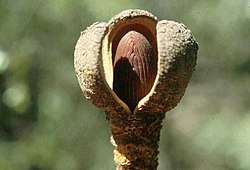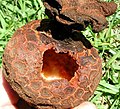| Hydnoroideae | |
|---|---|
 | |
| Prosopanche americana | |
| Scientific classification | |
| Kingdom: | Plantae |
| Clade: | Tracheophytes |
| Clade: | Angiosperms |
| Clade: | Magnoliids |
| Order: | Piperales |
| Family: | Aristolochiaceae |
| Subfamily: | Hydnoroideae Walpers |
| Genera | |
 | |
| Hydnoroideae distribution map | |
Hydnoroideae is a subfamily of parasitic flowering plants in the order Piperales. Traditionally, and as recently as the APG III system it given family rank under the name Hydnoraceae. [1] It is now submerged in the Aristolochiaceae. [2] [3] It contains two genera, Hydnora and Prosopanche : [2]
Contents
- Prosopanche is native to Central and South America;
- Hydnora can be found in semi-arid to desert regions of Africa, the Arabian Peninsula, and Madagascar.
Members of this subfamily have been described as the strangest plants in the world. [4]








